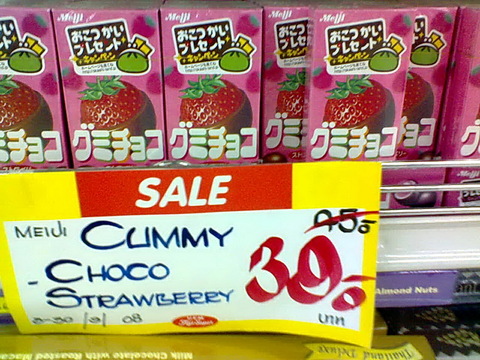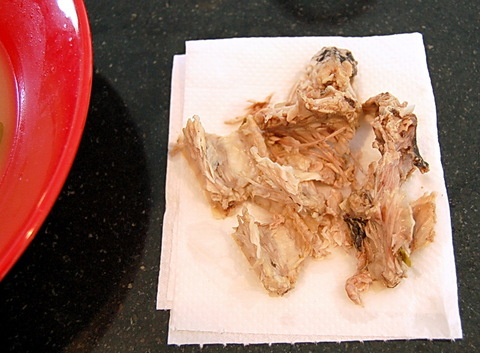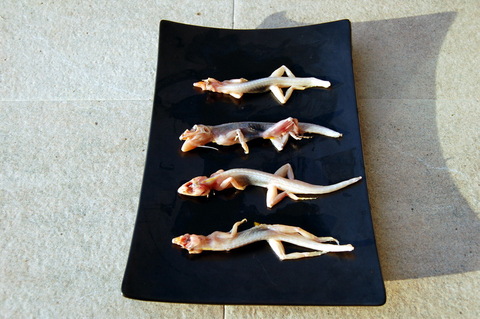
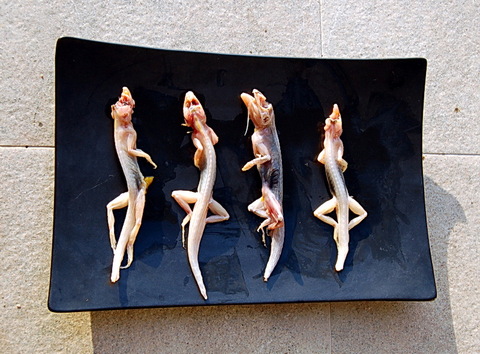
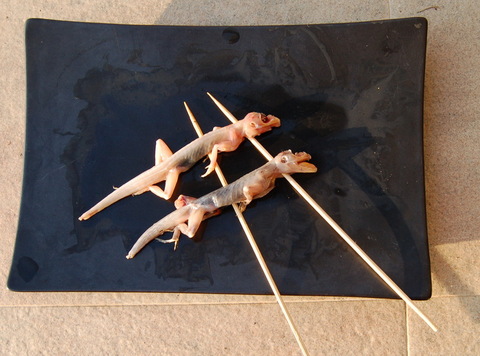

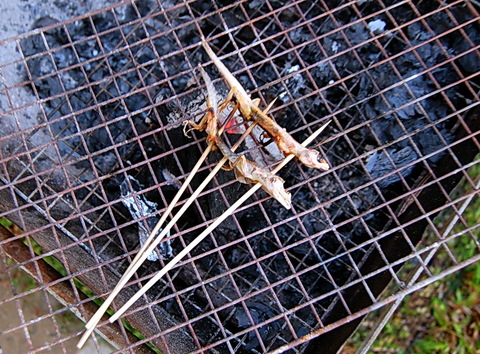
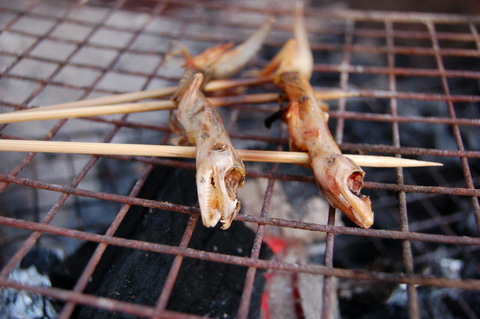
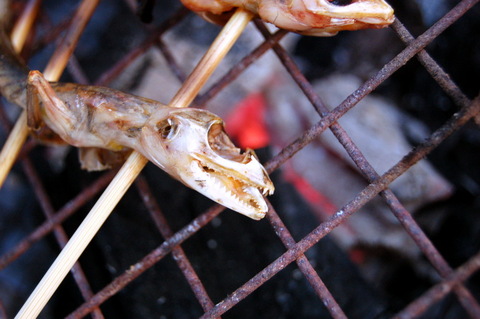
Thai chameleons are surprisingly tasty.
Further explanation will follow in another post…
Category: Food
Nattokinase vs. amyloid fibrils
Attention: My nattoburger invention may now save you from Alzheimer’s.
Using Thai rice for risotto…
.. and it’s taking a loooooooong time.
Also, I have no parmesan. Maybe I’ll use spotted gecko spittle…
Improvise, improvise, improvise.
Eating Mickey (or, how I overcame one of my last food prejudices)
I ask that you have an open mind about this post, because the conclusion may surprise you – it sure surprised me.
Here I am with my pal Mickey Rat:

Mickey was a gift from Max’s babysitter’s husband, who went hunting for the fat critters in the rice fields last Friday night. Mickey came dressed and with all fur removed, and upon first inspection seemed clean enough… Why then did the mere sight of Mickey’s long tail cause such feelings of repulsion and disgust in me? Therein lies the irony: Originally, we were to be given a much larger present, but it was determined that such a large specimen might turn us off to rodents all together (This was excellent foresight on the giver’s part.).
To sum things up, I fought through all the icky feelings and prejudices and decided on the spot that Mickey was going to roast on my trusty ghetto grill that very evening. I would call up some friends both to bolster my courage and share this important experience with someone. I had a plan, I had a rat… and I was going to eat it.
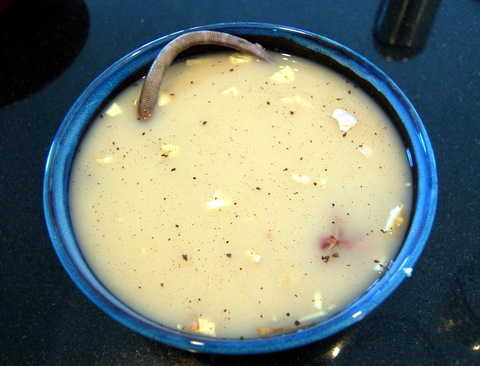
Ingredients for J’s Special Field Rat Marinade
- 1 tbsp. salt
- 1 tbsp. nampla (refined fish sauce)
- some ground black pepper
- 1/2 cup milk
- 30cc cheap whiskey
- whatever crusty remains you can sweep out of your herb drawer
- enough water to immerse rat
The milk is a trick I’ve seen used by grilled chicken vendors. I’d like to believe that there are enzymes in milk that help soften the meat, but the vendors just tell me they do it because that’s how they were taught by their friends. Unscientific bitches.
Anyway, I digress. Mickey was bound for the grill.
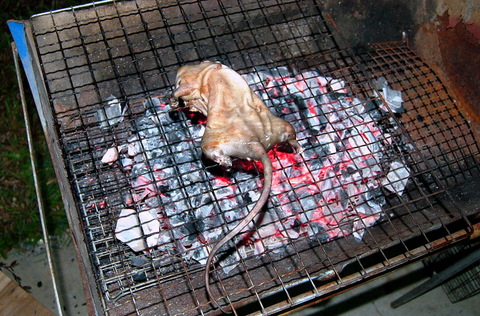
We (by that time friends had arrived) cooked the main course of the night quite slowly. First I seared both sides over the hot spots of the coals and then slow roasted 20 minutes to a side. The skin was quite fatty, like a suckling pig, and drips of juice caused merry flameups over the coals. It smelled… good. After the rat was halfway done, I also started grilling chicken wings which I had marinated in a same same but different kind of marinade. The idea was to use the chicken as a control, since basically everyone says everything takes like chicken.
So what does a fat, juicy field rat that’s eats rice almost exclusively (the people who hunt them know because they open their stomachs to see) taste like? Scroll down for our verdict:
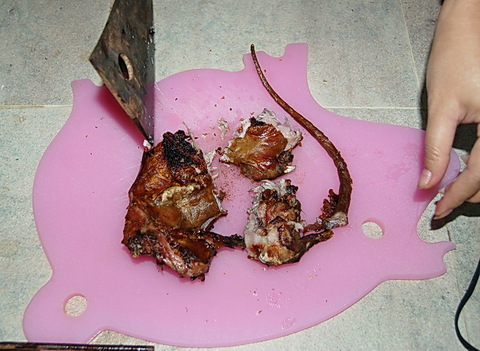
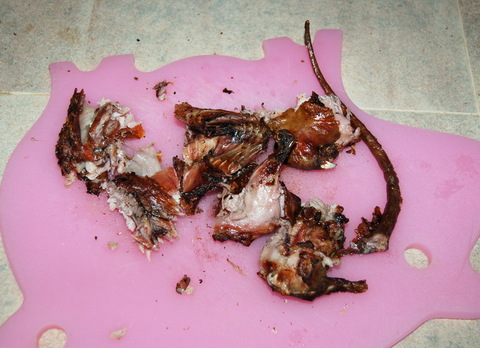
.
.
.
.
.
.
.
.
.
.
.
.
.
.
.
.
.
.
.
.
.
.
.
.
.
IT WAS DELICIOUS.
I couldn’t believe how good it was… First of all, it was perfectly grilled, but you could perfectly grill a marinated penguin and it probably would not taste very good. This was choice meat.
Yes, I would eat it again.
Yes, it did have overtones of chicken. No, it wasn’t smelly or gamey or gross in any way. The marinade and slow cooking rendered the meat soft yet pleasantly textured. The skin was crispy and closest to a roast suckling pig, I think.
/////////////////////////////////
So the next time you encounter a story about how rat meat is coming into fashion in India again or how grilled rat outsells chicken in the Vietnam countryside, just remember: It may not just be because rat meat is cheap. It may very well be because it tastes good.
Volunteering in Kalasin

Last week a few of us teachers were asked to visit some classes being taught on a volunteer basis by our Business English major students out in Kalasin. We went out without much info and assumed these were classes being taught at a school. As it turned out, one of our student’s family had created an ad hoc classroom outside their house and was hosting free lessons for two weeks since schools are mostly on holiday during October. Children from their village as well as neighboring villages attended, with younger kids coming in the morning and older ones in the afternoon, perhaps 30 kids per session.
The classes were being taught by a few of our students who stayed at the house for the duration of the project.
We went and basically had a lot of fun thinking up activities on the spot… I sweat a lot as it was a really hot day, so I can honestly say that I contributed a lot of salt to my polo shirt.
Our student’s house/farm has a shrimp pond out back, so our reward for lunch was huge platters of steamed prawns, raw prawns with garlic, and epic tom yum goong with shrimp the size of mini-lobsters in it.
We also helped out with the afternoon class and took a quick trip to a popular “beach” up the road just a couple kilos, at the Lampao Dam reservoir.
All in all it was a great day, and the dedication of our students really impressed us. When asked why they were doing it, they said they didn’t want to just waste their holidays away. Well done!
Quick ‘n Dirty Beef Panang
Beef Panang is considered a dry curry (for Thailand at least) because it contains less roux (liquid base), and specifically, less coconut milk than other Thai curries. It is also one of the best uses for lean/tough beef, which is great since that’s pretty much all we have around here. Panang is an easy dish to make and my way is even easier than most. I’ve tried it the normally advocated way, by heating curry paste in coconut milk first, but I’ve found this is a waste of time when using ready-made curry paste. So without further ado:
INGREDIENTS
- Beef – Any cut. Any quantity approximating that in the photos below (about 1.5 pounds).
- Thai red curry paste – Suitable quantity depends on brand; see photos below for reference
- Coconut milk – About one cup
- Fresh kaffir lime leaves – Slice these into strips. I used 2-3 big leaves in the photos below.
- Nampla (filtered fish sauce) – Suitable quantity depends on brand; I only used a couple dashes since I was using a fairly pungent brand. Remember, the only 2 reasons to use nampla are to make things SALTIER and FUNKIER – it doesn’t make a dish magically Thai, but it sure can funktify (esp. if you throw it in a hot frying pan).
- OPTIONAL: Raw cane sugar – A tablespoon or so. I forego the use of sugar because I can’t stand sweet curries, and this dish already contains coconut milk.
DIRECTIONS
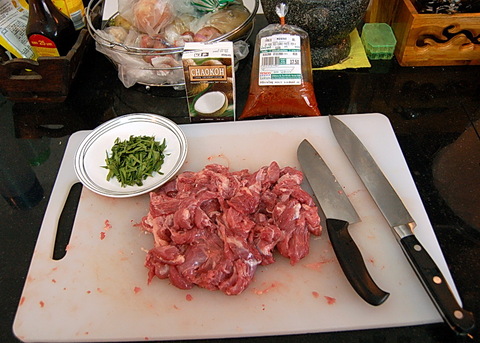
Cut the beef into strips. Traditionally, it should be cut into thinner strips than this, but I like bite-sized chunks. Cut the kaffir lime leaves up as well. The baggie in the background contains the red curry paste (we only used about half).
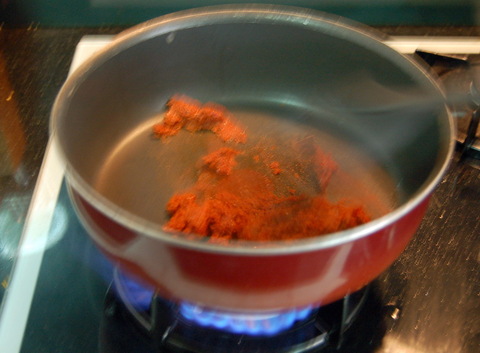
Heat a bit of vegetable oil in the pan and add the red curry paste. Fry it for a couple minutes on medium high heat to activate it, stirring rapidly to prevent sticking and burning. Then add the meat and stir often.
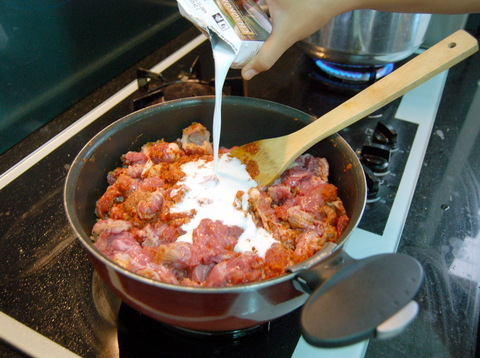
Did I forget to mention that Nam was cooking while I took photos? Anyway, the baby started waking up at this point so the coconut milk was added earlier than usual – we usually wait until the meat is slightly browned but it turned out not to make a difference. Also, the Quick ‘n Dirty series of recipes is designed for those that need to display adaptability on occasion, so they are meant to be stretched and improvised upon.
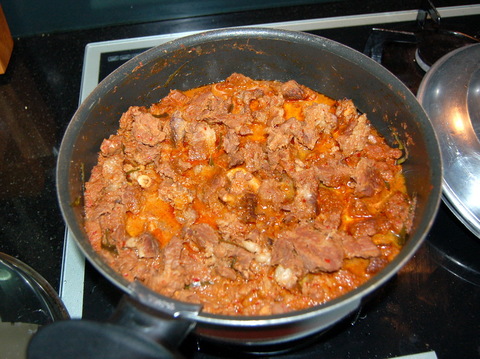
After the coconut milk is added, add a couple splashes of nampra (be careful, it’s really salty! You can always add more later, as well as sugar if you want) and also the lime leaves. Then turn the heat down to low-medium and let it simmer until either the meat becomes unbelievable soft and succulent, or tempted by the heavenly smell, you start scooping ladlefuls of panang onto hot mounds of rice and let the little piggy in you take over.
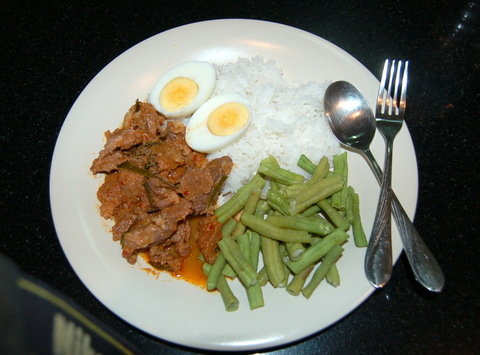
Alternatively, you can serve with boiled egg halves and veggies of some kind.
Note that you can eat the lime leaves, but they are a bit tough. I usually put them to the side.
///////////////////////////////////////////////
This is C. Buddha signing off with today’s Quick ‘n Dirty recipe – funky and delicious, yet simple and semi-authentic-ish Beef Panang.
Insect appetizers
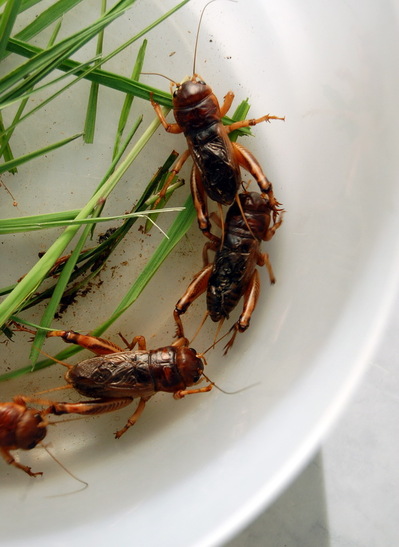
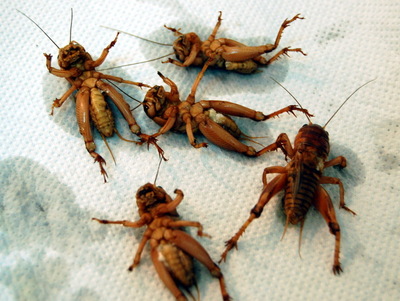
These went really well with the snake soup last week. We forgot to take photos of them past the prep stage, though. They were salted and deep fried, and then their heads were taken off which allowed easy deveining ala shrimp. As far as I could tell they were a cross between a cricket and a potato bug (mmm, potatoes), but as large as your thumb.
It tastes like chicken…
I had snake soup for breakfast this morning. It was one of the snakes on this page.
More to follow.

